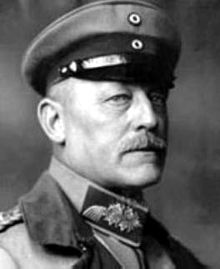Oskar von Hutier
Oskar von Hutier | |
|---|---|
 | |
| Born | 27 August 1857 Erfurt, Province of Saxony |
| Died | 5 December 1934 (aged 77) Berlin, Nazi Germany |
| Allegiance | |
| Service/ | |
| Years of service | 1875–1919 |
| Rank | General der Infanterie |
| Battles/wars | World War I |
| Awards | Pour le Mérite |
Oskar Emil von Hutier (27 August 1857 – 5 December 1934) was a
During the
After retiring from the Army in 1919, Hutier presided over the German Officers' League until his death on 5 December 1934. He was among leaders who contended that the Army had been betrayed by enemies at home.
Biography
Oskar von Hutier was born in
Hutier married Fanni Ludendorff,[3] and had three children. Their son Oskar was seriously wounded at the Battle of Verdun in 1916.[4]
World War I

Hutier spent the first year of the First World War as a divisional commander in France. There, he commanded the 1st Guards Infantry Division in the Second Army. He commanded the unit during the First Battle of the Marne, and remained on the Western Front until April 1915, when he was transferred to the Eastern Front. There, on 4 April, he took command of the XXI Corps of the Tenth Army.[5][6] He briefly commanded the Army Detachment D from 2 January to 22 April in 1917. On 22 April, he was promoted to General der Infanterie (General of the Infantry) and placed in command of the Eighth Army.[6][7]
On 3 September 1917, Hutier, commanding the Eighth Army, ended the two-year siege of the Russian city of
After arriving on the Western Front, Hutier was placed in command of the newly formed
Later in June, Hutier directed an offensive toward Noyon, which made initial gains but broke down in the face of stiff Allied resistance. For the rest of the war, Hutier's Eighteenth Army fought on the defensive while the Allies launched a strategic counter-offensive that culminated in Germany's total defeat by November.[7]
Later life
Following the
Decorations and awards
- Pour le Mérite with Oak Leaves
- Order of the Red Eagle, 2nd class with Crown and Star
- Order of the Crown, 2nd class (Prussia)
- Iron Cross of 1914, 1st and 2nd class
- Service Award(Prussia)
- Commander Second Class of the Order of the Zähringer Lion (Baden)
- Military Merit Order, 2nd class with Star (Bavaria)
- Knight's Cross, First Class of the Ludwig Order (Hesse-Darmstadt)
- Grand Cross of the Order of Philip the Magnanimous (Hesse-Darmstadt)
- Commander of the Order of the Griffon (Mecklenburg-Schwerin)
- Commander of the House and Merit Order of Peter Frederick Louis (Oldenburg)
- Grand Cross of the Albert Order (Saxony)
- Commander Second Class of the Ducal Saxe-Ernestine House Order
- Grand Cross of the Order of the Dannebrog (Denmark)
- Knight Grand Cross of the Royal Victorian Order (United Kingdom)
- Commander of the Order of Orange-Nassau (Netherlands)
Citations
- ^ a b Gudmundsson, p. xiii
- ^ a b Pawley, p. 47
- ^ "From the Aisne to the Marne". The Independent. 15 June 1918. p. 436. Retrieved 6 January 2013.
- ^ Wheeler, p. 298
- ^ Tucker & Roberts, p. 899
- ^ a b c Pawly, p. 48
- ^ a b c d e f Tucker & Roberts, p. 900
- ^ Gudmundsson, pp. 114–l16
- ^ Gudmundsson, pp. 120–121
- ^ Barrett, pp. 52, 225
- ^ Gudmundsson, p. 120
References
- Barrett, Michael B. (2008). Operation Albion. Bloomington, IN: Indiana University Press. ISBN 978-0-253-34969-9.
- Gudmundsson, Bruce (1989). Stormtroop Tactics: Innovation in the German Army, 1914–1918. New York, NY: Praeger. ISBN 0-275-93328-8.
- Pawly, Ronald (2012). The Kaiser's Warlords: German Commanders of World War I. Oxford, UK: Osprey. ISBN 978-1-780-96630-4.
- Tucker, Spencer; Roberts, Priscilla (2005). World War I: A Student Encyclopedia. Santa Barbara, CA: ABC-CLIO. ISBN 1-851-09879-8.
- Wheeler, Edward J., ed. (November 1918). "Hutier: The Great German Expert in Retreat". Current Opinion. LXV (5): 297–298. Retrieved 5 January 2013.
